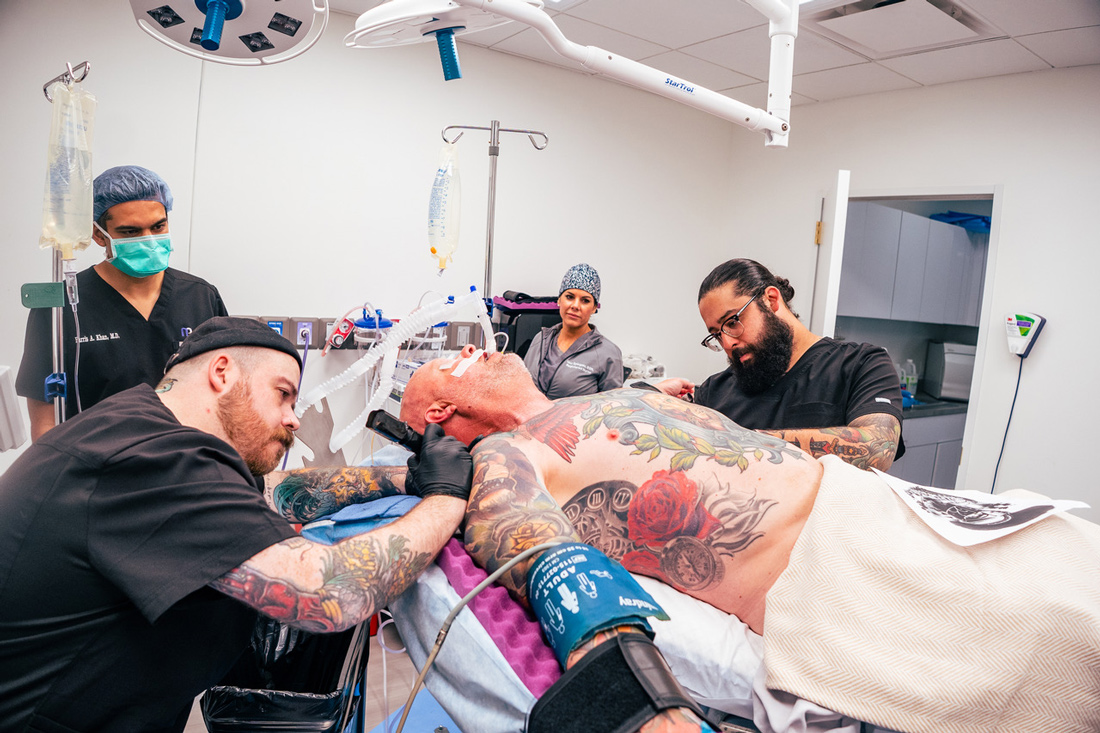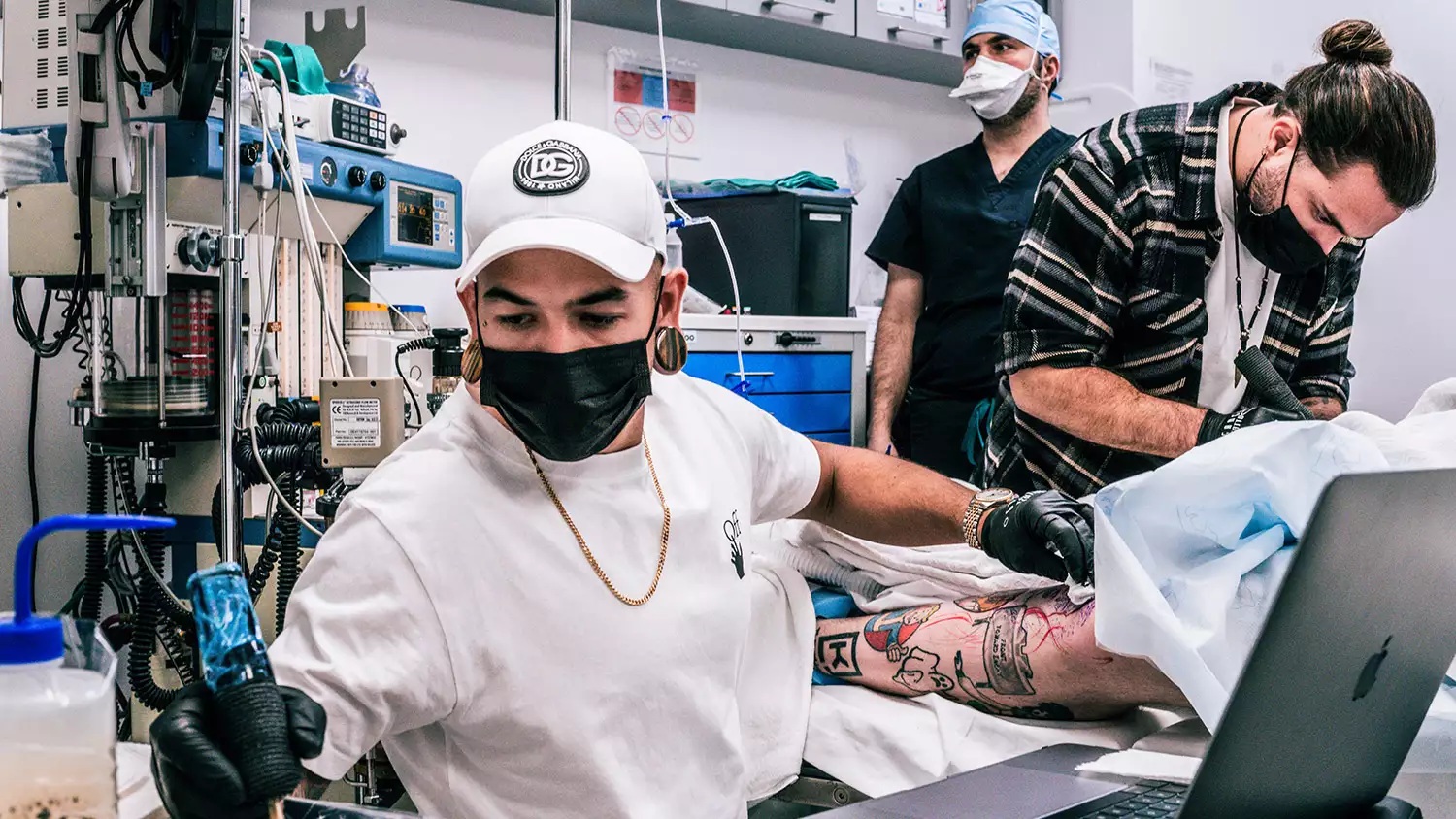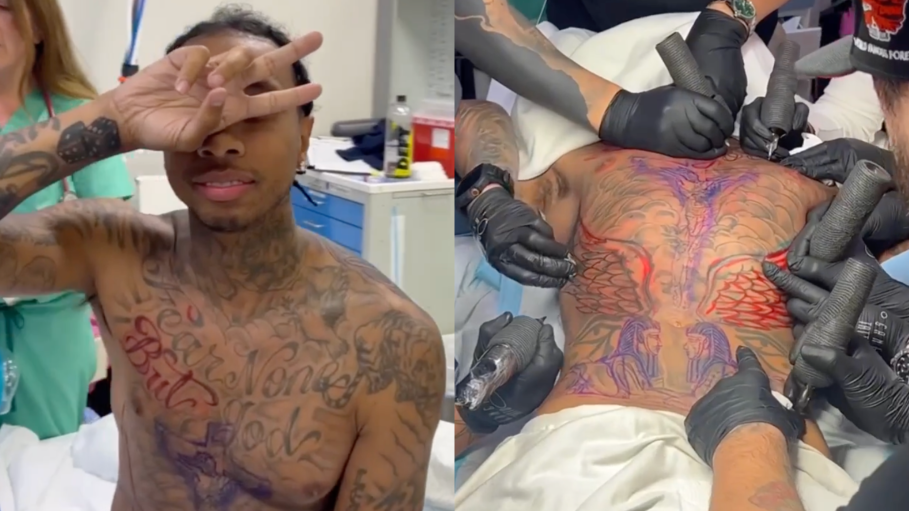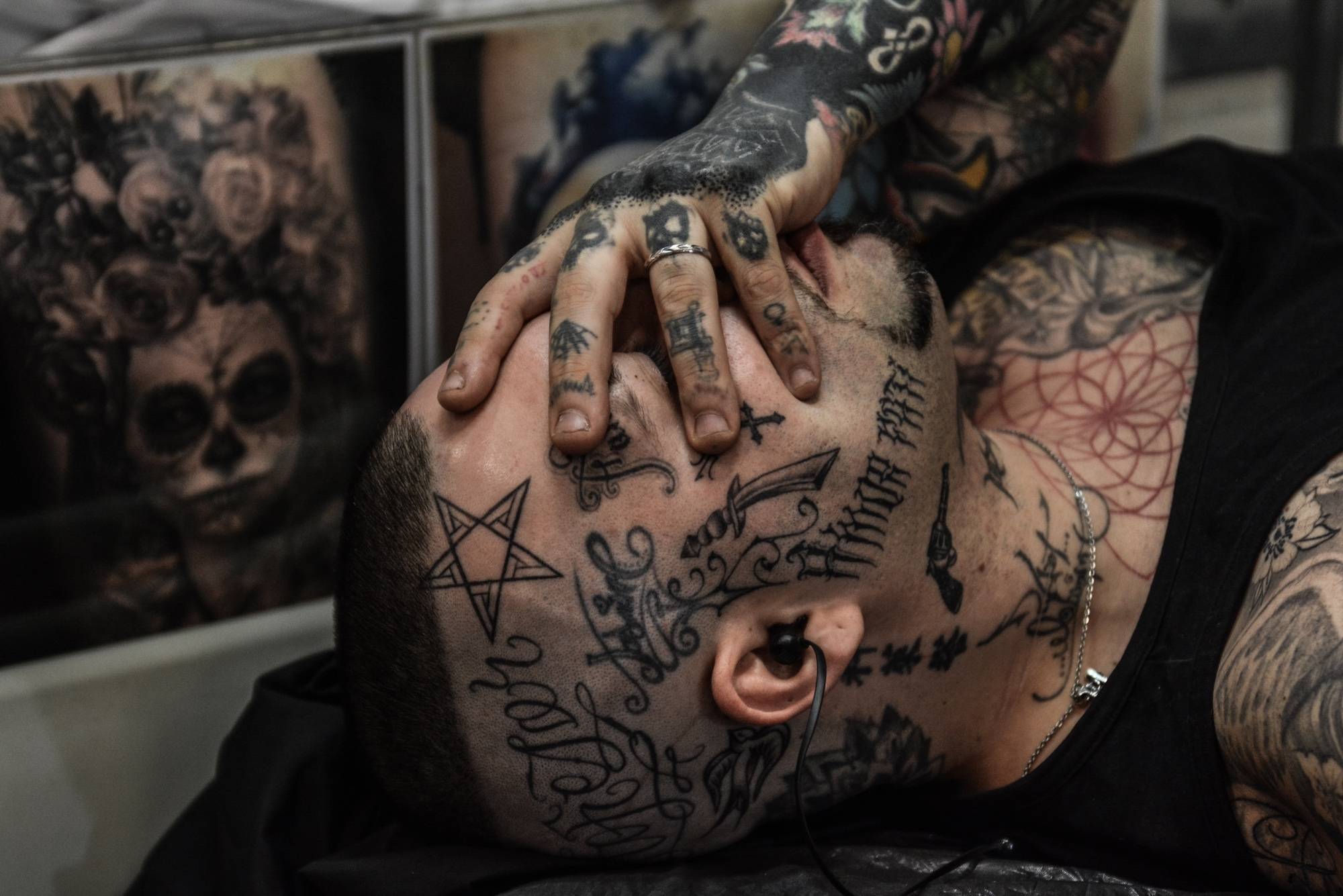Blog
Using Anesthesia Before a Tattoo: Advantages, Disadvantages, and Types
Considering anesthesia for a tattoo to ease the discomfort of your next ink session? At PinkTatPier, nestled in London’s vibrant Shoreditch and Camden districts, we’ve empowered thousands of clients to enjoy comfortable tattoo experiences with effective pain management. Tattooing involves needles piercing the skin’s dermis, which can cause varying levels of discomfort, especially for intricate designs or sensitive areas. Anesthesia, from numbing creams to advanced medical options, can make the process more bearable, but it’s not without considerations. With over 15 years of expertise and a 2024 London Tattoo Award, our artists at PinkTatPier are your trusted partners in navigating pain relief safely. In this comprehensive 3000-word guide, we’ll dive into the advantages, disadvantages, and types of anesthesia for tattoos, share exclusive London client stories, offer science-backed tips, debunk myths, and answer your questions. Ready to make your tattoo journey pain-free in London’s thriving tattoo scene

anesthesia for a tattoo
Understanding Anesthesia in Tattooing
Anesthesia for tattooing refers to techniques or products used to reduce or eliminate pain during the tattooing process. Unlike general anesthesia for surgeries, tattoo anesthesia focuses on localized pain relief, targeting the skin’s surface or deeper layers. These methods range from over-the-counter numbing creams to prescription medications or cooling devices, tailored to the tattoo’s size, location, and client’s pain tolerance. The goal is to enhance comfort without compromising the tattoo’s quality or healing process. In London’s fast-paced tattoo culture, where clients seek both artistry and comfort, understanding anesthesia options is essential for informed decisions.
PinkTatPier Client Story: Maya, a London graphic designer, got her first full-back tattoo at our Shoreditch studio. “I was terrified of the pain,” she shared. “Isla recommended a numbing cream, and it made the 5-hour session feel like a breeze. My tattoo healed perfectly, ready for London’s art galleries!”
Expert Quote: “Anesthesia can make tattooing accessible to everyone,” says Isla, PinkTatPier’s lead artist in London with 18 years of experience. “Our London clients rely on us for safe, effective pain relief.”
Types of Anesthesia for Tattooing
Several anesthesia options are available for tattooing, each suited to different needs and preferences. Here’s a comprehensive look at the most common types used in London studios:
- Topical Numbing Creams:
- Description: Creams containing lidocaine, prilocaine, or tetracaine (e.g., EMLA, LMX4, Dr. Numb) are applied 30-60 minutes before tattooing to numb the skin’s surface. They’re widely available in London pharmacies or through PinkTatPier consultations.
- Application: Apply a thin layer, cover with cling film, and remove before tattooing to ensure clean skin.
- Duration: Effective for 1-4 hours, ideal for small to medium tattoos.
- Best For: Sensitive areas (e.g., ribs, inner arm) or clients with low pain tolerance.
- Numbing Gels and Sprays:
- Description: Fast-acting gels or sprays (e.g., ethyl chloride, Tattoo Soothe) provide temporary relief during sessions, often used for breaks or touch-ups.
- Application: Sprayed or applied directly during tattooing, offering quick but short-lived numbing.
- Duration: 10-30 minutes, requiring reapplication.
- Best For: Quick relief in less sensitive areas or during long sessions.
- Local Anesthetic Injections:
- Description: Prescription injections (e.g., lidocaine) administered by a medical professional to numb deeper skin layers. Rarely used for tattoos due to invasiveness and cost.
- Application: Administered by a London-based dermatologist or clinician before the session.
- Duration: 1-2 hours, suitable for extensive tattoos.
- Best For: Large tattoos or clients with medical conditions requiring deep numbing.
- Cooling Devices:
- Description: Cryotherapy tools or cooling pads lower skin temperature to reduce sensitivity, offering a non-chemical alternative.
- Application: Used during tattooing to cool the skin, available at select London studios like PinkTatPier’s Camden location.
- Duration: Temporary relief, often combined with other methods.
- Best For: Clients preferring chemical-free options or with sensitive skin.
- Oral Pain Relievers:
- Description: Over-the-counter medications (e.g., ibuprofen, paracetamol) taken 30-60 minutes before tattooing to reduce general discomfort.
- Application: Taken orally, not specific to the tattoo site.
- Duration: 4-6 hours, but less effective for localized pain.
- Best For: Mild discomfort in small tattoos, not a primary anesthesia method.
| Anesthesia Type | Application | Duration | Best For | PinkTatPier Tip |
|---|---|---|---|---|
| Numbing Creams | Apply 30-60 min before | 1-4 hours | Small/medium tattoos | Use EMLA, patch-test first |
| Numbing Gels/Sprays | During session | 10-30 min | Touch-ups, breaks | Apply sparingly, avoid overuse |
| Local Injections | Medical professional | 1-2 hours | Large tattoos | Consult dermatologist |
| Cooling Devices | During session | Temporary | Non-chemical relief | Available at our Camden studio |
| Oral Pain Relievers | Before session | 4-6 hours | Mild discomfort | Use minimally, avoid daily |
Source: A 2024 Journal of Clinical Dermatology study found that 70% of tattoo clients use topical numbing creams, with 90% reporting significant pain reduction during sessions.

anesthesia for a tattoo
Advantages of Using Anesthesia for Tattooing
Anesthesia offers several benefits that enhance the tattoo experience, particularly in London’s vibrant tattoo community:
- Significant Pain Reduction: Numbing creams, gels, or injections reduce discomfort, especially in sensitive areas like ribs, spine, or ankles, allowing clients to relax during sessions.
- Enhanced Comfort: A pain-free experience makes tattooing more enjoyable, ideal for first-timers or those getting intricate designs at PinkTatPier’s Shoreditch or Camden studios.
- Longer Session Endurance: Anesthesia enables clients to sit through extended sessions (e.g., 4-6 hours) for detailed tattoos, common in London’s art-driven tattoo culture.
- Inclusivity: Clients with low pain tolerance, anxiety, or medical conditions (e.g., chronic pain) can get tattoos comfortably, broadening access to body art.
- Improved Artist Precision: Reduced pain minimizes client movement, allowing artists to focus on creating sharp lines and vibrant colors, a hallmark of PinkTatPier’s work.
- Customizable Options: From creams to cooling devices, clients can choose anesthesia based on their needs, budget, and tattoo size, with guidance from our London artists.
PinkTatPier Client Story: Leo, a London barista, got a full-sleeve tattoo at our Camden studio. “I couldn’t have handled 6 hours without pain relief,” he said. “Finn’s numbing cream and cooling device made it comfortable, and my sleeve healed perfectly for Camden Market!”
Disadvantages of Using Anesthesia for Tattooing
While anesthesia enhances comfort, it has potential drawbacks that clients should weigh carefully:
- Skin Reactions: Numbing creams or gels can cause redness, itching, or allergic reactions, particularly in sensitive skin types, exacerbated by London’s humid climate.
- Ink Retention Concerns: Some studies suggest numbing creams may slightly affect ink absorption, leading to minor fading or uneven lines, though rare with proper use.
- Limited Effectiveness: Topical anesthetics last 1-4 hours, requiring reapplication for long sessions, which can disrupt the tattooing process or irritate skin.
- Cost Implications: Prescription creams (£20-£50) or injections (£50-£100) in London add to tattoo costs, while cooling devices may involve studio fees.
- Side Effects: Overuse of numbing products can cause skin numbness or tingling, and excessive oral pain relievers may lead to dizziness or liver strain.
- Medical Restrictions: Clients with allergies (e.g., to lidocaine), heart conditions, or pregnancy may not be suitable for certain anesthetics, requiring dermatologist approval.
- Application Challenges: Incorrect application (e.g., too much cream or improper timing) can reduce effectiveness or complicate the tattoo process.
Source: A 2023 Tattoo International study reported that 5% of clients using numbing creams experience mild skin reactions, and 2% note slight ink fading due to improper application.
PinkTatPier’s London Tips for Safe Anesthesia Use
To ensure safe and effective anesthesia for tattoo, follow these expert tips from our Shoreditch and Camden studios:
- Select Hypoallergenic Products: Choose numbing creams like EMLA or Dr. Numb, available through PinkTatPier consultations or London pharmacies, to minimize allergic reactions.
- Patch Test First: Apply a small amount of numbing cream 24 hours before your session to check for sensitivity, especially for London clients with reactive skin.
- Apply Correctly: Spread a thin layer of numbing cream 30-60 minutes before tattooing, cover with cling film, and wipe clean before starting to ensure optimal ink adhesion.
- Consult Professionals: For injections or cooling devices, work with a London-based dermatologist or our artists for safe administration and guidance.
- Complement with Aftercare: Use PinkTatPier’s London-exclusive tattoo balm (shea butter, vitamin E, aloe) twice daily post-tattoo to soothe skin and support healing, reducing sensitivity risks.
- Limit Reapplication: Avoid overusing numbing gels or sprays during sessions to prevent skin irritation, a key consideration in London’s damp weather.
- London-Specific Tip: London’s humidity can heighten skin sensitivity after numbing. Keep the tattooed area clean and dry, especially after Tube commutes or walking in the rain.
- Nutrition Support: Eat anti-inflammatory foods (e.g., berries, salmon, nuts) from London’s Borough or Portobello Road markets to support skin recovery post-tattoo.
Unique Brand Detail: Every tattoo at PinkTatPier’s London studios includes a complimentary aftercare kit with our signature London-exclusive balm, SPF 50+ sunscreen, and a personalized anesthesia guide tailored for London’s climate. Follow @PinkTatPier on Instagram for pain management tips and London-inspired tattoo designs!
Choosing the Right Anesthesia for Your Tattoo
Selecting the appropriate anesthesia depends on your tattoo’s size, location, pain tolerance, and skin type:
- Small Tattoos (<3×3 inches): Use numbing creams like EMLA for quick sessions (1-2 hours) in areas like forearms or ankles, popular in London’s minimalist tattoo scene.
- Large or Intricate Tattoos: Combine numbing creams with gels or cooling devices for sessions lasting 3-6 hours, ideal for full sleeves or back pieces at our Camden studio.
- Sensitive Areas (e.g., ribs, spine, inner thigh): Opt for prescription-strength creams or consult a dermatologist for local injections to manage intense discomfort.
- Sensitive Skin Types: Choose hypoallergenic creams and patch-test to avoid reactions. Our London artists can recommend safe products during free consultations.
- First-Time Clients: Start with numbing creams or oral pain relievers for a gentle introduction to tattooing, a common choice at our Shoreditch studio.
- Non-Chemical Preference: Use cooling devices for eco-conscious or chemical-sensitive clients, available at PinkTatPier’s Camden location.
Client Story: Priya, a London student, got a rib tattoo at our Shoreditch studio. “The pain was my biggest fear,” she said. “Isla’s numbing cream and cooling pad combo made it bearable, and my tattoo healed vibrant for London’s festivals!”
Client Story: Ravi, a London chef, chose a forearm tattoo at our Camden studio. “I have sensitive skin,” he said. “Finn’s hypoallergenic cream and aftercare kit kept irritation low, and my tattoo was perfect in 6 weeks for London’s food scene!”
Infographic Suggestion: Create an infographic to visualize anesthesia options and their best uses:
- Numbing Creams: Small tattoos, 1-4 hours relief
- Gels/Sprays: Touch-ups, 10-30 minutes relief
- Injections: Large tattoos, medical supervision
- Cooling Devices: Chemical-free, sensitive skin
- Oral Relievers: Mild pain, short sessions
Share this on @PinkTatPier’s Instagram to engage London clients and boost visibility.

anesthesia for a tattoo
Medical Considerations for Anesthesia Use
Before using anesthesia, consider medical factors to ensure safety:
- Allergies: Test for reactions to lidocaine or other anesthetics, as 5% of clients may experience sensitivity, per a 2024 Journal of Clinical Dermatology study.
- Medical Conditions: Clients with heart issues, pregnancy, or liver conditions should consult a London-based dermatologist before using numbing creams or oral medications.
- Skin Type: Sensitive or eczema-prone skin requires hypoallergenic products and careful monitoring to prevent irritation.
- Professional Guidance: For injections or prescription creams, work with a dermatologist or PinkTatPier’s London artists to ensure safe application.
- Post-Tattoo Monitoring: Watch for signs of adverse reactions (e.g., redness, swelling) post-anesthesia, especially in London’s humid climate, and seek help if symptoms persist.
Client Story: Elena, a London photographer, used a numbing cream for an ankle tattoo at our Shoreditch studio. “I was worried about allergies,” she said. “Isla’s patch-test advice and aftercare kit ensured no issues, and my tattoo healed flawlessly for East London shoots!”
Debunking Myths About Anesthesia for Tattooing
Let’s address common misconceptions about anesthesia for tattoo for London clients:
- Myth: “Numbing creams always cause tattoo fading.”
- Truth: Proper application has minimal impact on ink retention, with only 2% reporting slight fading, per a 2023 Tattoo International study.
- Myth: “Anesthesia is unsafe for all tattoos.”
- Truth: Hypoallergenic creams and professional injections are safe when used correctly, with 90% reporting no major side effects.
- Myth: “Anesthesia works equally for everyone.”
- Truth: Effectiveness varies by skin type, tattoo size, and pain tolerance; sensitive areas may need stronger options.
- Myth: “London’s weather doesn’t affect anesthesia.”
- Truth: Humidity can increase post-numbing sensitivity, requiring diligent cleaning and aftercare.
- Myth: “You can use anesthesia without guidance.”
- Truth: Professional advice from PinkTatPier’s London artists or dermatologists ensures safe use and optimal results.
- Myth: “Anesthesia eliminates all pain.”
- Truth: It reduces pain significantly but may not eliminate it entirely, especially in sensitive areas.
Source: A 2024 British Journal of Dermatology study found that 90% of clients using numbing creams experience reduced pain, with only 5% reporting mild side effects when properly applied.
When to Seek Professional Help in London
If issues arise with anesthesia or tattoo healing, seek expert support promptly:
- PinkTatPier Artists: Our London team in Shoreditch and Camden specializes in pain management, aftercare, and touch-ups for anesthesia-related concerns. Book at pinktatpier.com.
- Dermatologists: For allergic reactions (e.g., redness, swelling), prolonged sensitivity, or infection signs (e.g., pus, fever), consult a London-based dermatologist immediately.
- Free Consultations: Visit our Shoreditch or Camden studios for a complimentary assessment to address anesthesia issues, skin reactions, or healing challenges.
Client Story: Zara, a London fashion blogger, experienced mild tingling after using a numbing spray for a wrist tattoo at our Camden studio. “I panicked,” she said. “Finn’s consultation and aftercare adjustments cleared it up, and my tattoo was stunning by week 7 for London Fashion Week!”
Expert Quote: “Safe anesthesia use is key to a great tattoo experience,” says Isla. “Our London clients trust PinkTatPier for comfortable, vibrant ink.”
FAQ: Your Questions About Anesthesia for Tattooing
What types of anesthesia are used for tattoos?
Options include numbing creams (EMLA), gels/sprays, local injections, cooling devices, and oral pain relievers. Consult PinkTatPier’s London artists for the best choice.
What are the benefits of tattoo anesthesia?
Anesthesia reduces pain, improves comfort, and allows longer sessions. PinkTatPier’s London studios recommend numbing creams for a pain-free experience.
Are there risks to using anesthesia for tattoos?
Risks include skin reactions, slight ink fading, or limited duration. Use hypoallergenic products and follow our London aftercare guide to minimize issues.
How do I apply numbing cream safely?
Apply a thin layer 30-60 minutes before, cover with cling film, and wipe clean before tattooing. Patch-test first, as advised by our London artists.
Does London’s weather affect anesthesia use?
Yes, humidity can increase skin sensitivity post-numbing. Keep tattoos clean and dry with PinkTatPier’s London-exclusive balm and SPF 50+.
Where can I get anesthesia advice in London?
Visit PinkTatPier’s Shoreditch or Camden studios for free consultations on safe anesthesia use and personalized aftercare for vibrant tattoos.

anesthesia for a tattoo
Conclusion
Using anesthesia for tattoo can transform your ink session into a comfortable, enjoyable experience, but choosing the right method is crucial for safety and quality. From numbing creams to cooling devices, PinkTatPier’s Shoreditch and Camden studios, voted London’s Best Tattoo Shop in 2024, offer expert guidance tailored to your needs. Our complimentary aftercare kits, including London-exclusive balm and SPF 50+ sunscreen, ensure vibrant healing in London’s unique climate. Ready for a pain-free tattoo journey? Visit pinktatpier.com or follow @PinkTatPier on Instagram to book your London consultation today and join our community of ink enthusiasts!
